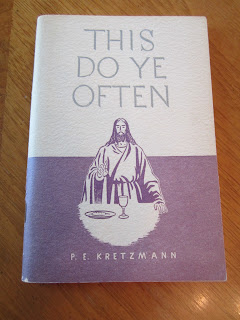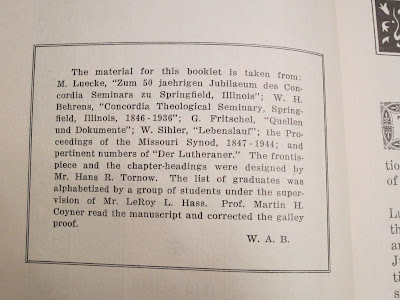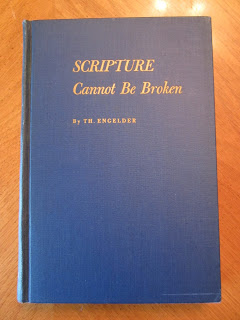First published in 1926, CPH's Bible History References by F. Rupprecht were linked with the Comprehensive Bible History of 1918. However, the most popular and widespread version is the "revised and enlarged" updated version of 1947 (pictured and reviewed here), which enjoyed numerous reprintings. These volumes can be purchased through Anchor Publications here or use this page to obtain an old copy.
The updating of 1947 coordinated the Bible History References with the new/updated resources used by the Synod at the time. These were the Advanced Bible History of 1936 (the updating of the Comprehensive Bible History), the 1943 Small Catechism and Questions, and the--then new!--TLH of 1941. There were also other minor additions and expansions.
Covering the same 140 Bible stories of the Advanced Bible History, the reference notes in the volume are tied to particular words or phrases from each story. There are also brief excursuses on important topics/questions. There are additional suggested tie-ins to the Catechism, hymn verses, and additional Bible readings at the end of each lesson.
I am sure that I have said it before, but I'll say it again: I am constantly impressed by the Synod's resources for children's Bible history. Most notable is the the focus on the Promise of the Seed (Messiah) throughout the Old Testament and the Christocentricity of the New Testament notes.
Besides excellent introductions to each major section of biblical history, additional appendices in the O.T. Volume include:
Brief Review of Jewish History from the End of the Captivity to the Birth of Christ
Some Messianic Prophecies and Their Fulfillments
Types of Christ
Bird's Eye View of the Old and New Testaments
Suggestions to Pupils on How to Study a Lesson in Bible History
Biblical Weights, Measures, Money, and Time
Chronological Tables of the Old Testament
Pronouncing Glossary
Topical Index
Indexed Bible Atlas
and in the N.T. Volume:
Summary of Paul's Activity
Biblical Weights, Measures, Money, and Time
New Testament Chronology
Pronouncing Glossary
Topical Index
A portion of the foreword to Bible History References may summarize it best:
The References will be found useful by anyone who is interested in a study of popular selections from the Bible. Pastor and teachers in parochial schools, Sunday schools, and vacation Bible schools have found them especially helpful. Study of the References provides the Bible Teacher with the wider historical, social, economic, geographical, archaeological, and doctrinal background necessary from best success in his teaching. The language is simple, and the explanation of difficult words and passages is clear and concise. The maps, charts, illustrations, and historical tables help to visualize much of the content.
...and they are wonderful resources regardless of what additional materials you are using, if any...
While the References follow the sequence of the Advanced Bible History, they may be used equally well with only the Bible in hand. In short, these volumes may be used conveniently by any teacher of Bible stories, regardless of the particular lesson materials which he may use in his class.
Need to Get Level: 10/10
Seriously, it really is a 10. If you are a pastor or layman, you should have this on your shelf for a reference of what the most basic questions and important points to teach are concerning 140 of the most central stories of the Bible. This is a perfect aid for biblical survey classes or the education of children...or adults. Parents should especially consider these volumes as they provide to you a resource for opening the Scriptures for your children-and you!
--------------------------------------------------------------------------------------
More coordinated resources:
Go here to read more about the Advanced Bible History. Or here to buy a copy. The older version, Comprehensive Bible History, can also be bought here.
Anchor Publications still has Bible History References for sale here, and also has two supplementary works that are designed to work with the Advanced (or Comprehensive) Bible History and Bible History References. I do not own nor have looked through these resources, however I am confident that they are worth checking into if you wish to use the Advanced Bible History at home, church, or school.
1. Bible History Explained and Applied by K.K. Miller ($13.50, 264 pages)
2. Exercises in Bible History, 2 volumes, Old and New Testaments, by H.A. Merta and W.A. Siems ($9.50, 150 pages each)
The above two resources can be found on this page.























.jpg)



